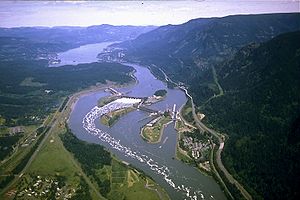Op/Ed: 100% Renewable Energy for BC
By Marc Lee, for the Canadian Centre for Policy Alternatives, from Policy Note
It is well established that we need targets and timelines for reducing the greenhouse gas (GHG) emissions that are causing climate change. BC’s latest targets include a 40% reduction in GHG emissions by 2030, 60% by 2040 and 80% by 2050.
And yet, politics-as-usual has made climate targets a bit of a joke. It’s all too common in Canada for federal and provincial politicians to set far-off targets and then not take the actions needed to meet them.
We are still waiting on a plan for BC to meet its new targets, and CCPA and others have proposed a more rigorous process of annual carbon budgets to provide the framework and accountability necessary for such a task.
Yet before a plan could even be tabled, the provincial government moved the yardsticks by permitting a massive new LNG Canada facility on the north coast aimed at shipping BC gas to Asia (which we critiqued here).
Even as we struggle to meet our targets, a more important question is whether the targets are even aggressive enough. The most recent UN Intergovernmental Panel on Climate Change (IPCC) report suggests we need a level of ambition well beyond current global efforts if we are to meet the Paris Agreement’s aspirational target of keeping the global temperature increase to 1.5 degrees.
While an 80% reduction in emissions by 2050 seemed sufficient a decade ago, climate scientists are now calling for something like “net zero” emissions by mid-century—meaning any emissions from fossil fuels would need to be balanced by efforts to suck carbon out of the atmosphere.
The Logic of 100% Renewables
The overarching question we should be asking ourselves is how fast we can get to 100% renewable energy and not just for electricity, but for home heating, transportation and industry.
This is the central theme of Mark Jacobson’s work: how to power the world with renewables—without tricks like nuclear power, carbon capture or biomass—just wind, water and solar (WWS) technologies. It’s a compelling message for an era that continues to seek more fossil fuels to dig out of the ground. Mark’s work tells us there is another way to meet our energy needs without undermining the future, one that is better for our health and produces more jobs than the fossil fuel industry.
In 2011, Mark co-founded The Solutions Project, a non-profit that combines science, business and culture to educate the public about 100% clean energy roadmaps. In 2013, his group developed individual WWS energy plans for the 50 states in the United States, and in 2017 for 139 countries in the world. They calculated down to the number of wind turbines and solar arrays that would be needed in each jurisdiction, along with estimates of the number of jobs that would be created.
A number of jurisdictions have started to accept the logic of achieving 100% renewable energy. More than 85 cities around the world have made this commitment, including the City of Vancouver with its Renewable City Action Plan, which aspires to be a 100% renewable city by 2050. Many other national and sub-national governments have made the lesser pledge of 100% renewable electricity (i.e., only the electric grid, not fuel combusted in buildings, cars and industry).
California, with a population greater than Canada’s, recently announced plans to “achieve carbon neutrality” economy-wide by 2045.
A new law (SB 100) targets 100% renewable electricity by the same date, but that only accounts for 16% of California’s emissions. The other 84% are targetted by an executive order from Governor Jerry Brown. While an executive order could be dismissed as symbolic, such orders have set the stage for organizing followed by climate legislation in California’s past (read energy analyst David Roberts’ recap here). And while the concept of carbon neutrality can include gimmicks like offsets, carbon capture and carbon storage, the intent is an important signal to the rest of the world.
(Below: Mark Jacobsen, of Stanford University. Article continues below picture.)

Getting to 100% Renewables
Mark Jacobson’s work has been particularly influential on California’s (and other jurisdictions’) push on climate policy. He provides the roadmap for how it can be done and how much it would cost. He says first of all, electrify almost everything and make sure that electricity is from 100% renewables. Some niches will still require liquid fuels, but for the most part think electric cars and trucks on the road, electric pumps for heating and cooling buildings and electrification of industry.
To meet future global energy demand with 100% renewables entails a few steps.
Jacobson plots business-as-usual growth of energy demand, but then argues that actual demand will stay at current levels under the shift to 100% renewables. That’s because one important saving in a 100% renewable scenario is the energy overhead of extracting, processing and transporting fossil fuels is no longer needed. This represents about 13% of current global energy demand.
The switch also enables more efficient energy use.
Using electricity is more efficient than combusting fossil fuels. For example, only a small fraction (15-20%) of the energy from gasoline moves a vehicle, the rest is heat whereas electric engines are much more efficient (80% use) with only a small amount of heat wasted. In addition, we can push the boundaries of energy efficiency improvements in various applications by developing better lighting and appliances, etc.
From here it is just a matter of replacing fossil fuels with renewable energy: Jacobson models a scenario where all energy worldwide is produced as follows—wind (23% of total demand from on-shore and 14% off-shore) and solar power (30% utility scale, 15% residential photovoltaic (PV) and 12% other buildings PV), along with hydropower (4%) and geothermal (1%). Notably, Jacobson does not foresee a need for new major hydro dams.
Jacobson highlights the myriad ways human ingenuity can be brought to the current challenge, including common wind turbines and solar arrays. It is worth noting, however, that the costs of these options have decreased dramatically. Other solutions are not so obvious. Using electric heat pumps to move heat and cold around is applicable at a household scale but can also work for university campuses and whole housing developments (including the Okotoks development south of Calgary where summer heat is pumped into rocks below ground for use in the winter).
Bottom line: this revolution is technically possible. Politics are a bigger hurdle because of the hundreds of billions of dollars invested in the status quo.
What does this mean for BC?
BC is in an enviable starting position because of its large base of hydroelectric power. This facilitates integration with smaller-scale renewables as they require some form of baseload power because the sun is not always shining and wind is not always blowing. BC’s hydro dams act like batteries for storing power and allow it be dispatched at will, meaning the utility can easily match electricity supply and demand in real time.
What about BC Hydro’s Site C dam? Site C is experiencing both economic and technical issues: the final cost of the dam is uncertain due to cost over-runs; there is a substantial GHG footprint associated with construction and flooding land; and for the most part, the power is intended to electrify upstream fracking and gas processing operations and LNG plants. In contrast, Jacobson’s primary focus is on solar and wind options, both of which are showing declining costs over time.
Using Jacobson’s estimates, the future is quite economical with electricity costing in the 10-10.6 cents per kWh range across all sectors, world-wide. To put that in perspective, BC Hydro has some of the lowest residential rates in North America with a first tier at 8.6 cents per kWh and a second tier of 12.9 cents for consumption above a threshold amount (although those rates are likely to rise due to financial pressures at BC Hydro).
The benefits of using renewable energy include not just stopping global warming in its tracks. Air pollution associated with fossil fuel energy causes millions of premature deaths per year. In addition to the economic benefits of between $45-55 trillion per year world-wide, there would also be large domestic benefits in terms of energy security.
Can we truly get to 100% renewables?
The last portion of the effort, the final 5-10%, represents some hard-to-decarbonize areas, including air travel, shipping and some industrial processes. But we have several decades to develop responses, technically and politically. Even if we only get to 98% that would still be an almost miraculous achievement by today’s standards.
The key lesson from Mark Jacobson’s work is that we have good reason to be optimistic, technologically, economically and in public opinion. If we can collectively align our efforts and overcome politics-as-usual, the world could be powered by 100% renewables.
BC should step up and try to win this race. It would give an underlying purpose to our economy that is a very different direction from saying yes to polluting LNG megaprojects.
Marc Lee is a Senior Economistat the CCPA’s BC Office. In addition to tracking federal and provincial budgets and economic trends, Marc has published on a range of topics from poverty and inequality to globalization and international trade to public services and regulation. Marc is Co-Director of the Climate Justice Project, a research partnership with UBC's School of Community and Regional Planning that examines the links between climate change policies and social justice.


























